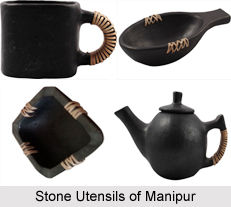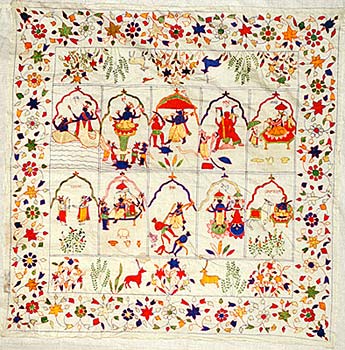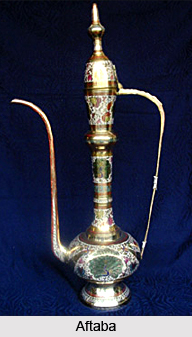 "Puanchei" is the most colourful of the Puans and is a coveted possession of every Mizo lady. This is almost invariably an item of their marriage outfit, besides being the most commonly used costume in their festive dances.
"Puanchei" is the most colourful of the Puans and is a coveted possession of every Mizo lady. This is almost invariably an item of their marriage outfit, besides being the most commonly used costume in their festive dances.
Design of Puanchei
It is interesting to note that many of the designs of the traditional Mizo Puans, make their appearance in the Puanchei in some way or other. Therefore, the two beautiful deep black compactly woven woollen bands of the Ngotekherh make their conspicuous appearance in the Puanchei. Besides these two black bands, a number of deep red woollen bands, each about two to three centimetres wide, are also woven vertically with similar compactness on the two edges of the Puan. What is most distinctive of this weaving is that none of the coloured threads on the warp are allowed to make their appearance against the aforementioned black and red woollen bands. Not even a streak anywhere is visible enough to make it a first rate product. They also have to ensure, besides close weaving, that at no part of these stripes occurs any shrinkage, given careless handling of the weft and warp threads takes place. The surface displays stripes of different dimensions with a preponderance of red stripes of different shades. These are combined tastefully with other stripes of deep colours such as green, yellow, blue and black, standing against the broad white stripes. As against the other Puans, the Puanchei is woven in three pieces instead of two and sewn together very delicately to make a complete whole fabric. The piece which forms the middle one is narrower than the other two pieces and contains the striped patterns as also the designed embroidery work throughout the length of the Puan. This resembles the design of the Thangchhuah Puan, artistically incorporated in the Puanchei.
The designs on the stripes of the Puanchei follow the pattern of Disul as well. As mentioned earlier, the middle piece in weaving the Puanchei displays the greatest amount of embroidery work. The three narrow stripes on the piece are embroidered following the Disul pattern, running across the breadth of the piece along the two ends. The middle piece of the Puanchei is usually about 30 to 35 centimetres broad. At the two extreme ends of the piece along the length, run two black stripes, next to which in the inner side run two narrower white stripes with Disul-pattern embroidered work thereon. Next to these embroidered stripes, run deep green stripes. Between these two green stripes, there is a pair of red stripes, each almost double the breadth of the green ones separated from them by very thin yellow lines. Between these two broad red stripes stands symmetrically in the middle, a white stripe which is again embroidered with the Disul pattern thereon. On the two edges of the middle piece across its breadth, stand a large number of red and white stripes separated by very thin lines of green, yellow, blue and pink colours. Running breadth wise, these stripes make a right angle with the main stripes and are covered with the Disul patterns of embroidery work. These patterns are of two geometrical shapes, namely, diamond and square. On some of the stripes, the diamond patterns are woven in different colours, each standing against the other touching their corners, thereby, producing isosceles triangles of different colours, one after the other between the squares.
The two side pieces of the Puanchei contain profuse embroidery work on the two edges, woven in the same pattern as that of the middle one. While these two are sewn up with the middle piece, it is done in such a way that they make one continuous whole cloth. One end, along the length of each piece is a broad deep border followed by narrow green, yellow, blue, deep pink and black stripes. Adjacent to these comes a broad white stripe, ending with other columns of narrow stripes of black, deep pink, green, yellow and red colours with a symmetrical combination of similar stripes of yellow, green, deep pink and black. This combination is again followed by another broad white stripe, which is sewn delicately with one end of the middle piece. The two pieces on either side of the middle piece are exactly similar, sewn on either side of it.
Next to the Puanchei, the traditional "Senior Puan" that held its popularity among Mizo women till the recent past. The background of these Puans could be of any colour, but the pattern of embroidered work thereon had a distinctive feature, comprising big diamond shaped patterns with little butterflies on either side, spaced suitably in between, running across the length of the Puan, a little above the lower edge. The pattern was woven with different stitches on different Puans, and the colour combination of the total embroidery was carefully planned out to provide an overall soothing effect. To provide some further variety, the embroidered work was expanded by weaving several lines of zigzag patterns in some of these Senior Puans, matching with the central diamond patterns on either side. The design, thus, became more appealing.
"Puancheite" is one of such types considered as a Senior Puan sometimes, but on many occasions considered a separate variety of Puan in itself. This may have been so named in view of the overall gorgeous effect of the total design which is very much in keeping with the similar gorgeous effect of the Puanchei. The background consists of deep red and black broad bands, running horizontally. All the embroidered work is done on the lower half of the fabric, leaving the upper half with plain broad red and black bands. This is the basic difference with the Senior Puan. The embroidery work in the lower half starts on the black bands, followed by the extreme red bands on the edge. Multicoloured diamonds in green, pink, blue, red and yellow colours run across the whole length of these bands. The space in between these diamonds is embellished with small diamonds of blue and yellow. The cloth, overall, looks elegant and vibrant with the incorporation of different designs of multiple colours.
Related articles
Textiles of Manipur
Crafts of Manipur
Tribes of Manipur
Indian Costumes
Weaving and Dyeing Craft
Mizos
Kukis
Puan
Textiles of Different Tribes of Manipur
Woollen Textiles, India



















